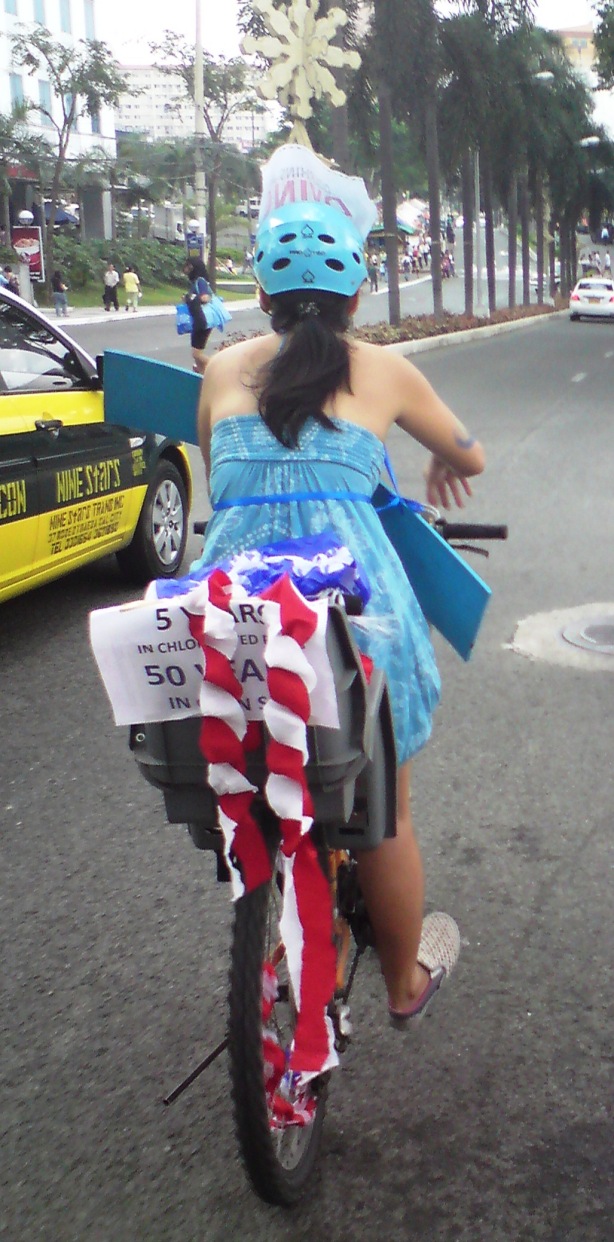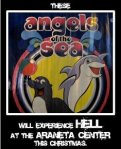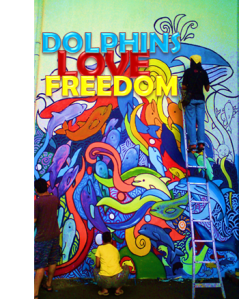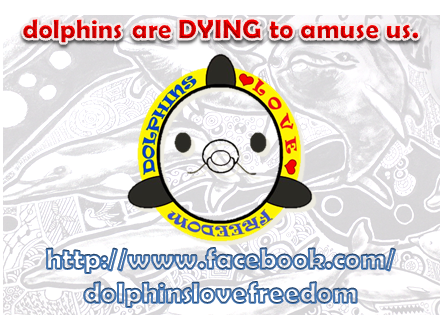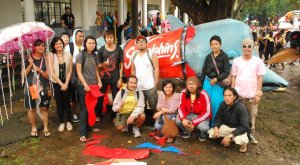12/31/2010 | 06:56 PM
Since Christmas Day, dolphins Tutti and Frutti have been performing five times a day in a small pool for an audience that pays to be entertained.
Supposedly entertainment for the holidays, Angels of the Sea at the Araneta Center features the dolphins, and the sea lions Jello and Jelli, performing tricks to the beat of deafening music, in a 12×18 foot pool.
According to Jose Avelino, spokesman of Indofil Seawonders Co. Ltd, the show’s organizer, the show is meant to create awareness to save the dolphins from the harmful conditions of their natural habitat.
“While these angels of the sea entertain the audience, their performance is also expected to translate into a human understanding that caring more about marine life is essential as both worlds (marine and human) are interconnected,” Avelino was quoted in a report published by Malaya.

Data from ‘magician’s hat’?
But several groups strongly disagree — and they have been actively campaigning against the show since they learned of preparations in the Telus parking lot in Araneta Center, where the show was eventually held.
“No marine mammal expert would agree with the data they came up with. Perhaps they pulled their data from a from magician’s hat. Nagiimbento sila kasi they need to protect their business,” said A.G. Sano of the advocacy group Dolphins Love Freedom Network.
But Indofil Seawonders Co. Ltd claims that it wants the entire nation to witness how much it values dolphins and how it firmly believes that marine life complements human life and balances the ecology.
The company also insists that dolphins have a right to live any place where they are most secure.
In the wild, dolphins travel in family groups called pods and are used to swimming distances of up to 100 miles (161 kilometers) a day.
Blaring music ‘deafening’ for dolphins
Their hearing is extremely sensitive, and any kind of noise causes them stress, according to animal welfare activists.
Clearly, performing dolphins in a traveling show do not have the space they need and would have in the wild. Apart from that, the loud music and applause during a show is harmful to their hearing.
Anna Cabrera, program director of the Philippine Animal Welfare Society (PAWS), explains that dolphins are echolocators, and locate objects by emitting sounds and detecting the reflections given back. This is how they “see,” she explained.
When they are in a small pool, they cannot use echo-location., Cabrera said.
“It’s like putting a person in a small drum and shouting loudly. Nakakabingi na echo ng mga sigaw ng mga tao, ng music na pinapatugtog nila The loud applause and the blaring music is deafening [for them],” she says.
Requests to ban dolphin show
The Dolphins Love Freedom Network, PAWS, Earth Island Institute (EII) Philippines and the Marine Wildlife Watch of the Philippines (MWWP) have written to both the Department of Agriculture (DA) Secretary Proceso Alcala and to the Araneta Center management, asking that the show be stopped—but to no avail.
“We had to coordinate with DA and BFAR [Bureau of Fisheries and Aquatic Resources] and all they said was, ‘Wala, wala namang permit’,” Sano said.
“The last time Earth Island talked to BFAR was the day before the (show’s) launch. So I don’t know kung ‘di talaga nila alam (So I don’t know if they really did not know [about the moves to ban the show],” he said.
Sano has been doing marine mammal research for the past eleven years.
“It’s either they’re incompetent, na hindi na nakakalusot sa ‘radar’ nila (that it went below their ‘radar’)or they were lying to Earth Island,” Sano said, adding that they were caught by surprise when they saw the show featured on morning shows of GMA7 and ABS-CBN.

Dolphin show permit ‘violated laws’?
It turns out that the Bureau of Animal Industry, which is an agency under the agriculture department, granted the organizers a permit to run the Angels of the Sea show from December 25 to January 2.
In their position paper sent to DA’s Alcala, the advocacy groups said that it “believe(d) that the BAI erred in its issuance of the permit as this violated the following laws: the Animal Welfare Act (Republic Act 8485) and the spirit behind the DA Administrative Order (AO) No. 8, which sets out the rules for the importation and release into the wild of plants and plant products derived from the use of modern biotechnology.
The show also violated the basic principle of allowing animals their freedom, a standard that should be part of BAI’s mission.
By granting the permit, the BAI also violated the dolphins’ freedom from pain and physical discomfort, from injury and disease, from fear and distress, and the animal’s freedom to conform to essential behavioral patterns, the groups said.
Profit for dolphin show organizers
Claiming that performing animals are cruelly exploited, the groups continued to hold protest actions — both outside and inside the show.
The groups pointed out that proceeds of the show are not intended to fund the dolphins’ interests, but only go to profit the event organizers.
“I’ve given some talks to some kids who’ve gone there and they don’t even know the body parts (of dolphins),” says Sano.
“So, aliw lang siya (It’s just entertainment), just for profit,” he said.
According to the animal welfare advocate, the trend in marine parks is to put up some money for research.
Even Seaworld —the huge American chain of marine mammal parks, oceanariums and animal theme parks— is known for giving out research grants to institutions all over the world, Sano said.
It needs to reinforce its claims that its shows are held for conservation, says Sano.
Sano’s research into marine mammals bagan after he watched The Cove, a 2009 documentary film that describes the annual killing of dolphins in a Park at Taiji, Wakayama, Japan.
Sano thought it was something people couldn’t just watch sitting down. “Mass slaughteryung ginagawa nila [The film depicted the mass slaughter of dophins]. I saw the connection between the slaughter and dolphin shows in general,” he said.
“Kasi if you allow these types of businesses, it’s teaching the whole generation of Filipinos that it’s okay to take something from the wild and make money out of it,” said Sano, who along with other members of the Dolphins Love Freedom network has painted over 23,000 dolphins over 120 walls all over the Philippines.

Dolphin show protest placards, tarps, t-shirts
On Christmas Day, Sano, together with two other members of the Dolphins Love Freedom, May-i Fabros and Dakila Cutab, biked around the Araneta Center parking lot with fake dolphins headgears, carrying placards that read “Dolphins are dying to amuse you…”; “5 years in chlorinated pools, 50 years in the open seas”; “Don’t watch intelligent dolphins perform stupid human tricks”; and “Watch MMFF2010 not Dolphin Shows.”
They also distributed to curious passers-by some fliers, which contained info about dolphins and the question, “Do you think they’re happy performing here?”
They were stopped by the Araneta Center security, but were later permitted to campaign after they explained their cause.
On Thursday, the groups took the protest a bit further—enough to provoke slightly aggressive response from security officers at the show.
They displayed large tarpaulins by the pool area, while the dolphins were performing. The tarpaulins read: “This is animal cruelty”, “Captivity kills!” and “Conservation or Exploitation?”
They were able to remain at the center of the tent for a few minutes before security officers escorted them out of the show area.

In the meantime, four protesters stood on the bleachers wearing shirts that read “No to dolphin shows.” But soon after the protesters holding the tarpaulins left, those in t-shirts were also brusquely instructed to leave.
“You bought tickets to watch, not to disrupt our show!” a security officer shouted when the protesters argued that they were just wearing shirts.
As the protesters left, they distributed fliers to those watching the show. However, security officers escorting them grabbed the fliers and crumpled them before throwing them away.
Not discouraged, the animal rights activists continued their protest action outside the show areas for over an hour, passing out flyers to passers-by and speaking with them about dolphins.
Educating audiences on marine conservation
Meanwhile, Angels of the Sea OIC Amando Inocentes defended the show.
“Mga bata, they get to experience seeing close up yung ating mga mammals, ang dolphins natin, ang sea lions. (Children get to experience seeing mammals, dolphins and sea lions, close up), he said.
“And may mga portion kami rito with trivia questions educating our young children on how to conserve our environment,” said Inocentes in a report on QTV’s Balitanghali. (There’s a portion of the show where children are asked to answer trivia questions, and this helps educate the audience on how to conserve our environment.)
“Tutti and Frutti now are 18 and 20 years old, respectively — which belies the statement saying that pag in captivity (when in captivity)mga ganyan, five years lang ang lifespan nila (the [dolphin’s] lifespan is only five years. This is proof, and they’re still very strong,” said Inocentes.
As with any production, the show must go on, despite the protests.
Previous dolphin shows won’t be done again
For Sano, he has no hopes that the show will actually be stopped. He cites previous instances of dolphin shows which were allowed their full run by the SM Mall of Asia and Metrowalk in 2006 and 2007.
The managements of both malls did not cancel the shows, but instead pledged to never sponsor similar shows again, after they were met with picketing.
“The only objective is to appeal to them to not do it again,’ Sano said—noting however that his top appeal was for fireworks to be banned in Araneta Center. “It’s damaging to the dolphins,” he said. The New Year’s Eve would be particularly hard on the dolphins because of the noise would reverberate in the pool and the pollution would inevitably contaminate it.
The fact that they’re (Angels of the Sea) here in Manila shows that they’re not concerned about the welfare of the dolphins,” said Sano. If the organizers truly understood the behavior and the physiology of dolphins, they would know that their hearing is extremely sensitive.
“Tapos isu-subject nila sa ganyan, yung maingay na (Then they will subject [the dolphins] to Metro Manila noise and pollution. Imagine that,” he said in disgust.
“Nakakainis eh. (It’s infuriating) I don’t think (the) DA can do anything about it, because they’ve been hands off. Mahirap na asahan,” he said.
“So the best way is to appeal to them or Araneta (Center management) if they could do something about it,” he said.
So far, neither Indofil Seawonders Ltd. nor the Araneta Center has responded to the poignant appeals.
Commercial dolphin shows are prohibited in Australia and New Zealand, as well as in Latin American countries such as Brazil and Nicaragua.
Even dolphin broker Chris Porter, who once sold 25 dolphins to Singapore’s Resorts World Sentosa, has had a change of heart and is now an animal rights activist. — MRT/TJD/DM GMANews.TV



